Travel destinations in the north of Namibia

The north of Namibia is the most populated part of the country and here is either the Etosha park with its impressive animal world as also the last Nomads of Namibia, the Himbas. In relation to the south, this part is relatively green and humid, if those attributes can be mentioned at all in relation to such a desert country as Namibia is.
The capital of Namibia Windhoek
The first station of a visit to Namibia will be almost always the capital Windhoek. There are approximately 45 km from the airport to the city, thus it is very convenient to start the tour in Windhoek. This already makes sense due to the reason that one should avoid to travel for very long distances on the day of arrival, apart from the fact that Windhoek is a place that should be deeply explored.
In every part of the city one comes across the witnesses of the German past but still notices that one is actually in an African centre. Windhoek is, compared to German standards, a middle sized city with 170 000 inhabitants, but the only big city of Namibia. Upto a few years ago, the colonial history was still recognizable by the street's names, but recently, many were renamed. Anyway, fortunately, no iconoclasm took place and many testimonies of the partly very sad past of the country were left as monuments.
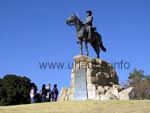
At first, there is to mention the equestrian monument that is standing in the city centre very closely to the old stronghold. It was exposed in the year 1912 for the birthday of the Emperor and states the names of the Germans who died during the Nama- and Herero war. Those thousands of victims form Nama's and Herero's side are not even mentioned. The question whether this monument should be let there repeatedely raises; We think it should, if the background is clarified accordingly.
At a few metres distance there is, together with the old stronghold, the oldest conserved building of the city in which today the state museum with an exhibition of Namibia from the colonial times up to date is accommodated. At a few metre's walk at the edge of the big park, there are two further emblems of Windhoek. The ink palace is the seat of the parliament and was arranged in the year 1913 in the colony style. At the front there is the Christus church, the apparently most famous building of Windhoek.
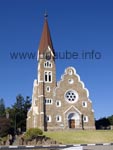
In contrast to the German colonial style, the St. George's Cathedral reminds on English cities. This is not very surprising, as it was built in the year 1925 when Namibia was administrated by South Africa. The National Gallery where works of contemporary Namibian artists are exposed and the Owela Museum are located in the Robert-Mugabe-boulevard. By continung walking down the boulevard, one gets to the gym that is world wide renowed due to the same named conference of 1975.
The actual centre with high-rises and business streets are located around the Independence Avenue, the former Kaiser street. Loafing through this place is a pleasure due to the attractive buildings, beautiful shops and coffee bars. A specially nice view to the capital city life is offered from the terrace of the Gathemann coffee bar. The clock tower that is visible everywhere located at the corner of the Independence Avenue and the Post Street Mall is considered as a central meeting point.
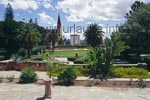
There are of course also small markets spread everywhere in the city centre in which some souvenirs are offered. From wood carvings, porcupline bristles, ostrich eggs and textiles up to bushman weapons, everything what could be interesting for the tourist is offered. The same stuff is also available in the numerous souvenir shops.
Our insider tip for shopping in Namibia, specially in Windhoek, are the clothes shops. The offer is cheap and in generally of top-quality. Specially the outdoor clothes are significantly cheaper than in Germany.
Windhoek also offers accommodations for every taste. Beside the big stars hotels there are also many small pensions and guest houses that maybe do not offer so much comfort but therefore they are more personal and much cheaper.
Swakopmund, the second biggest city of Namibia
In Swakopmund, the "most german" city of Africa, many colonial buildings remind on the history of the former German Southwest Africa. This dreamily appearing small city is, with 30.000 inhabitants, the second biggest city of Namibia. Located right at the Atlantic, it used to be the entrance gate to the colony. Due to this situation at the sea, Swakopmund also has a very good climate with pleasant temperatures even during the summer time.
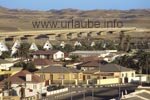
For visiting Swakopmund, one should plan at least 2-3 days, as there are no lack of sightseeings. Today, the former station built in the year 1901 is a luxury hotel and counts to the most beautiful buildings of the city; Also the former imperial main customs office has been rearranged and now, the museum of Swakopmund is accommodatred there, one of the most interesting ones of Namibia. Here, it is also possible to get some tours organized to the Rössing-uranium mine.
At the very proximity there is the summer residence of the president. In former times, this building was the imperial country court. The old post office, the Ludwig-Schröder-House, the Altona House, the Hohenzollern House and the Ritterburg are further buildings in colonial style that are worthwhile seeing. The red-white lighthouse that is the highest one of the city with a height of 21 m, is visible everywhere in Swakopmund. It was built in the year 1902 and then it was expanded in the year 1910 by further 10 metres. There is a very cozy garden restaurant at the bottom of the tower.
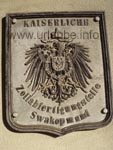
In general, there are plenty of nice and classy restaurants where oftenly also fresh fish is offered. From the Light House, that is located right at the sea, one has a wonderful view to the water and the sunset.
A visit to the Woermann House should also not be missing. The merchant from Hamburg had this built in half-timbered style in the year 1894 and then rearrange and expand in the year 1903. For a small mite, one gets the key to the Damara Tower from which one has an excellent view over the whole city and the surroundings with the dunes of the Namib desert.
In the aquarium, in front of the Hotel Adler, one promenades through some glass tunnels underneath the fishes. Beer lovers will be interested in the brewery that still today brews according to the German purity law.
Of course there are in Swakopmund beside the big hotels also some cozy accommodations that we personaly prefer instead of the big hotels. In the evenings, there are sentinels in front of the respective house that do not lose sight of the building during the night and are supposed to provide security. We could not judge about whether this is really necessary or just a pure measure of precaution. Anyway, we never felt in danger.
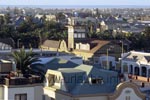
Being in Swakopmund, one of course wants to explore also the surroundings. On a paved road, we drive to Walvis Bay, the former British harbour. The drive passes some holiday houses standing in the middle of the desert sand and of a futuristic appearance. Walvis Bay itself does not offer any outstanding sightseeings, but by driving a piece further up to the lagoon, a delicacy of view points is waiting for the nature lovers. Here, thousands of flamingos, pelicans, seagulls and sea swallows are looking for food in the nutritious water.
At the most northern point of the headland that splits the lagoon, there is the Pelican Point with a light house and a small seal colony. But for this area, a cross-country vehicle is indispensable and it is only possible to drive during the time when the tide is low. There are travel agents offering some boat trips to the Pelican Point.
At the south of Walvis Bays, one already sees some huge white snow mountains from a distance. These are the salt dumps Salt Works that belong to the biggest salt producers of Africa and that are exploited from the seawater. It is possible to view this complex by giving previous notice.
What is still to be mentioned is that, with a tour to Sandwich Harbour, one of the most sophisticated off-road stretchs can be accomplished. But this tour is really demanding and should only be booked by real connoisseurs. In the chapter "Desert routes" there are further tips for excursions departing from Swakopmund.
Okonjima-Lodge
At approximately half of the way between the capital Windhoek and the Etosha Park, there is the Okonjima-Lodge. But those who have seen the signpost at the B1 are still far away from the destination. We still have about 25 km to make on unpaved roads on the complex of the lodge up to our accommodation. To be exactly, they are some different accommodations, thus there is the Main Camp, the Luxury Bush Camp and luxury double tents. We had rented a rounded hut in African style in the Luxury Bush Camp, a decision we did not regret.
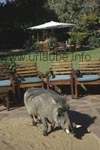
Our first acquaintanceship in Okonjima was an animal. By entering the reception in the main building, the in-house warthog lopped unhurriedly towards us demanding to be stroked. We came up against him many times and have to say that he was better educated than some people. During all the meals we had in the open terrace, our friend was present but remained discretely at the entrance.
The speciality of Okonjima is the special protection of the African big cats. In the complex of the farm, there is the Africat Foundation, an association for the protection of threatened big cats of Namibia. Here, some numerous orphaned or injured cheetahs, leopards and lions have found a provisional or permanent home. Of course, the prior aim is to give the animals again the opportunity to live wild again but if this is not possible, they stay in Okonjima. This problem is memorably shown and explained in the training centre of the foundation.
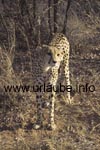
Of course, beside the theory, there is also the adventure in the wilderness. In the afternoon, we go to a game drive in order to look for some leopards. This is a very interesting matter, even though that we do not believe this is a fair play. With a direction finder, it is looked for those leopards wearing a transmitter. We criss-cross the complex but without any success. But then, just at the time of the sunset, we do find a leopard that is devouring a lum of meat at this moment. The vehicles drive one by one to the bush so that everybody has some minutes to observe the big cat. On the way back, some cold drinks are served in the last sunlight; Even though this looks like a staging, the encounter with the leopard in the wilderness is a highly interesting thing for the Europeans and an experience that one does not want to miss.
After dinner we go to an onservation post hoping that there are some animals in the food station. That night we are not lucky, as only a porcupine gets lost here. But this has to be accepted, as one is not in a zoo but in the wilderness and the animals sometimes do not always cooperate...
The next day starts early, when it is still dark. In an open cross-country vehicle we are driven outside into the scrubland and this time we are successful. The cheetahs we go to certainly live in a fenced open-air ground but of a size that does not give an impression of a zoo at all. There are fed on a regular basis and one can be sure to come across them. From the elevated chair of the cross-country vehicle, one can observe them very well without any disturbing screens or grates. By the way one also gets informed about many worth knowing things of these gracile big cats that are, unfortunately, in acute danger.
Ethosha National Park
Those who think on the big national parks of Africa will mention the Serengeti and the Krüger National Park of South Africa. The Ethosha Park in Namibia is less renowed but not less beautiful. It certainly does not achieve the size of the krüger Park, but with more than 22.000 km², it is, after all, half as big as Switzerland. It was already founded in the year 1907 as the area was jeopardized to be emptied by professional hunters. Today, the park belongs to one of the African areas with most animals and is one of the highlights of a trip to Namibia.
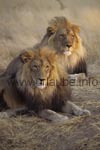
The whole park is fenced and only accessible through some gates. Beside of the numerous day visitors coming with a rented car or some guided tours, there is also the possibility to stay over night in one of the staturorial camps right in the camp. The advantage of this is that by this way, one can enjoy a lot more of this fascinating animal world. But the accommodations are scarce so that one has to book in time. All accommodations are located in the eastern and southern part of the park and specially the western park is barely frequented by the tourists.
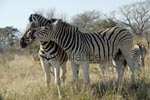
In the Etosha Park, the animal lovers fully get their money worth, as, apart from the Big Fives (except the buffalos), there are numerous other kinds of animals and the herds of the zebras, wildebeests and antelopes are really abundant today. The best time for the animal observations is, of course, the dry season. From June up to September when there is barely water available, all of them rush to the water holes and one can actually be sure to get them all in front of the camera.
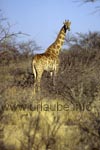
The behavioural pattern in the park is strictly regularized. It is strictly forbidden to leave the pistes that mostly are unfortified sand and dusty pistes. The same applies for leaving the vehicles. This is understandable, as the animals are certainly used to see the humans in the vehicles, but they are still wild animals that can get really dangerous. Thereby, the first to consider are the lions and the elephants, but also the wildebeests, zebras or baboons are not to mess with and after all, most of the fatal accidents are caused by the hippopotamus.
Almost a quarter of this complex is covered by the Etosha-pan. Sometimes, it is dry for years but then, after some intensive rainfalls, it converts to a huge lake. During this time, a special kind of experience is offered, as hundred thousands flamingos temporary populate this lake; Not far from the Halali Camp there is the possibility to get on a piste leading to the so-called Etosha Lookout and drive into the actual salt pan but only if it is completely dried out.
If one is in the Okaukuejo Camp or if one drives into the park through the Andersson Gate, a side trip to this fairy tale forest is worthwhile. Here, several hundred moringa trees grow that only exist in Namibia. In the fairy tale forest, the trunks are strangely grown together because elephants and giraffes repeatedly devoured them; Thus, it gets clear where the name comes from.
Mowani Mountain Camp, Damaraland
We already had heard a lot from Mowani Mountain Camp. By mentioning this travel destination, the connosseurs of Namibia got enthusiastic and admitted the beauty of the landscape there and the unique flair of the accommodations.
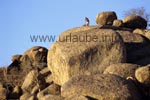
Our expectation was respectively great and we were not disappointed in this concern. According to our opinion, the Mowani Mountain Camp is one of the most beautiful accommodations of Namibia and can be recommended to all travellers. But thereby, the bitter aftertaste is the price level, as the accommodations are certainly not cheap in the Camp. But the name of the Camp does not deceive. It is derived from the Damarian word M'wani, that translated means "The place of god".
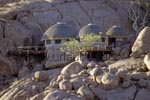
The Camp is located in the country of Damara in the north-west of namibia amidst a mountaineous landscape and in the proximity of some touristical attractions as the Brandberg, the Spitzkoppe, the Vingerklip, the petrified forest and not least one of the most renowed destinations of Namibia, Twyfelfontein with some stone age paintings and engravings of the San (bushmen).
It is possible to access the camp also with a normal car without any problem, there is no need of an all-wheel-drive. After the staff welcomed us with a cocktail and some wet cloths, we start to our first round. Mowani Mountain Camp is located amidst some imposing rock formations. The accommodations, luxury tents, are mounted at an areal height, cleverly adapted to the landscape and hidden between some huge pieces of rock.
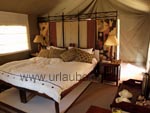
From the main building, a big African hut in the centre of the camp in which the restaurant is located, some paths lead to the respective accommodations in which really nothing is missing. Big beds, a table, chairs, and more than enough space for the clothes and the luggage enable a longer stay here to be very pleasant. But what specially fascinated us was the bath and the toilet, as this facility was very unusual for a European. These facilities are at the open air, right behind the tent, but they offer the luxury of a European bathroom as a WC, washing basin and a bath tube with cold and hot flowing water. In the first instance, this is very astonishing, but soon it gets normal. We think that here, a wonderful mix between luxury and nature has been fulfilled.
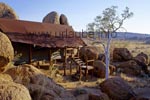
Of course, from time to time, one comes across an izard or a gecko in the bath tube or in the bed, but this also purely belongs to a holiday in Namibia. By having booked demi-pension, an excellent and abundant breakfast buffet and an excellent dinner are waiting for one to which every evening a drummer calls. The specialities of the kitchen are dishes made from koodoo- zebra- springbok- and ostrich meat. Due to the reason the tents are cleverly integrated into the rockscape, one can confidently relax and enjoy the dream view to the surroundings.
The offered half-day tours are also recomendable, for example the search of the desert elephants. A popular place to be for the pachyderms is the Huab river in the proximity of the camp. With a little luck one comes across to a herd with maybe even some young animals among the others. But as it is the usual case of the wild animals, there is of course no guarantee to be able to see them. But also in case of not being so lucky, one anyway experiences a beautiful excursion and, compared to the other tours to the desert elephants, this one is quite cheap.
The tour to the Twyfelfontein with its rock petroglyphs and rock engravings is an absolute must. Twyfelfontein means "fountain of doubt" in Afrikaans. A farmer had doubts whether the sparsely flowing fountain would provide sufficiently water.
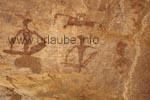
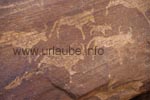
The rocks of Twyfelfontein reflect the heat very strongly, so that at noon time, it is almost unbearable there. This is also the reason why the tours take place in the very early morning and in the late afternoon. If one takes part on this tour, one should take in any case a big bottle of water and a cover for the head.
A tour on one's own to the Twyfelfontein is not worthwhile, as on one hand, an entrance fee has to be paid and the condition for entering is to have a local guide. Thus, it is better to book the tour straight away, also because it is relatively cheap. Moreover, one also gets many worth knowing things explained, as the guides fully understand their craft.
It is a very impressive feeling to stand on this spot and have these artworks of the San (bushmen) that are between 2400 and 6000 years old in natura in front of one. The extremely dry climate has conserved them very well. Up to date, the concrete purpose of these artworks is still not clear. But as in most of the cases they represent some kinds of animals, it is assumed that it was about hunting culture.
Another sightseeing are the "organ pipes", some approximately 100 million years old basalt pillars heighted approximately 5 m and only at a few kilometres distance from the Twyfelfontein. The burned mountain is supposed to glow as extinguishing fire in the light of the sun going down. We could not see this effect and were a little disappointed by this appearance.
At approximately 20 km distance frrm the Movani Mountain Camp at the road C 39 in direction to Korixas, there is an interesting natural wonder. The petrified forest, huge trunks that were buried with sand approximately 300 milion years ago and conserved by silicon dioxide offers the tourists today some impressive insights into the geology and mineralogy.
Karivo-Lodge
The area around the capital of Namibia Windhoek does not belong to those landscapes that are preferred by the tourists. But those who want to relax for some days and want to make some tours for the animal observation will find here some interesting and also excellent lodges or guest farms. They are specially attractive under the consideration of a stop in between after arriving or before leaving Namibia, due to their convenient location in the proximity to the airport.
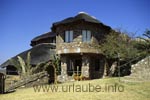
For example, the Karivo-Lodge is such an apt and also very recommendable accommodation that is only located at approximately 75 km at the nort-west of Windhoek. From here up to the international airport there are about 45 km, thus a distance of approximately 1 to 1,5 hours. Such distances make sense on the day of arrival/departure, as due to several reasons, long drives should be better made on other days, as there is always the risk not arrive in time at the airport due to a breakdown or due to the reason the place of the accommodation is much too far away. Moreover, one it tired after a long flight and still has to continue travelling.
The transfer from/to the airport to Windhoek is also a special service offered by the staff of the lodges. If one uses this service, one can also save 1 or 2 days rent for the car.
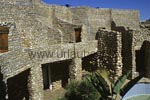
We came by ourselves and were relatively late. The dawn that is only very short in Africa already begun and in a short time it was going to get completely dark. Honestly, the stretch from the road to the lodge was the most difficult one of our trip. The way can be also done with a car without an all-wheel-drive, but therefore, some good nerves are required and it is better to drive this way "over hill and dale" better in he daylight. But the Karivo-Lodge compensates all inconveniences possibly occured, as it is one of the most beautifuil ones of Namibia.
The building is arranged in a shape of a ring and each suite has a big balcony from which there is a fantastic view to the wide plain. Some stairs lead up to another small room with a fireside and a second balcony. From this balcony, one can look into the inner courtyard with green plants and a waterfall. The whole building is made from natural stones and is integrated into the landscape in an excellent way.
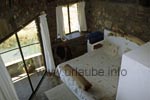
Actually it is unnecessary to mention that the hospitality, the service and catering deserve a top mark. But in Namibia, this is really nothing unusual and one of many reasons why the visitors are repeatedely attracted to this country.
Karivo is also a hunting farm, but we preferred to make a tour with our camera. Included in the price for an onver-night stay is a farm trip in which there is a lot of game visible as for example oryx-antelopes, springboks, ostrichs, koodoos, hartebeest mountain zebras, warthogs and the almost omnipresent pavians in this area.
Due to this reason, the planning of the trip should in any case include a time buffer so that one can enjoy this really impressive excursion. For the case that after this there is still some time left, Karivo offers a lot of possibilities to spend this time in a very exciting and sportive way. One can do some riding excursions and hiking tours on the mountains or simply be lazy at the swimming pool. Due to the proximity to the capital Windhoek, there is also mobile reception in the Karivo-Lodge, a thing that otherwise is not self evident in Namibia; As conclusion it can be said that a stay in the proximity of Windhoek can be also very attractive.

Back to the index Namibia
Author: Michael Nitzschke, Copyright: Patrick Wagner, www.tourist-guide.biz
|